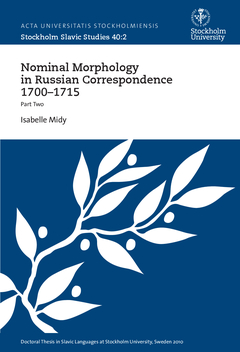The materials examined here consist of 121 Russian letters dating from 1700-1715. The present study aims to define a stage in linguistic evolution and analyze the morphological heterogeneity in the textual corpus. The letters are divided into three categories: private, semiofficial, and official. All nomina (substantives, adjectives, pronouns, and numerals) are registered and their occurrences processed statistically case by grammatical case. The focus is on linguistic features where a choice is possible and variation is in evidence. Conservatism asserts itself primarily in strongly standardized texts such as the official correspondence, while phonetic spelling reflecting akanie and dialectally influenced syncretism between different cases (e.g., the GDLsg) is observable mainly in the private letters, which consitute the least standardized category. There is a trend break among u-genitives and u-locatives, where our findings indicate that the u-ending is losing ground. A statistically established correlation between declensional type and the presence/absence of a coordinated adjunct is noted in the instrumental plural of masculine o-, jo-stems. The choice of the archaizing Ipl-ending suggests that repetition of the -mi- element is perceived to be redundant. In the singular paradigm of the adjective the feminine instrumental forms are strongly conservative, and the modern short ending occurs in only a few instances. In the nominative plural the modern ending -ye, -ie dominates for all cases and in all letter categories. The use of samyj for the comparative degree is not particularly prominent in these 18th-century letters. Because this descriptive comparison type developed in the 17th century, its use could have been expected to rise in the 18th, but our materials do not indicate any such increase. With few exceptions, pronouns generally display forms corresponding to modern usage. One notable deviation is the occurrence of a pronoun with an adjectival ending in the genitive singular (tago), but it is an idiosyncratic feature. Numerals for the most part correspond to modern usage, although their low frequency does not invite generalizations.


